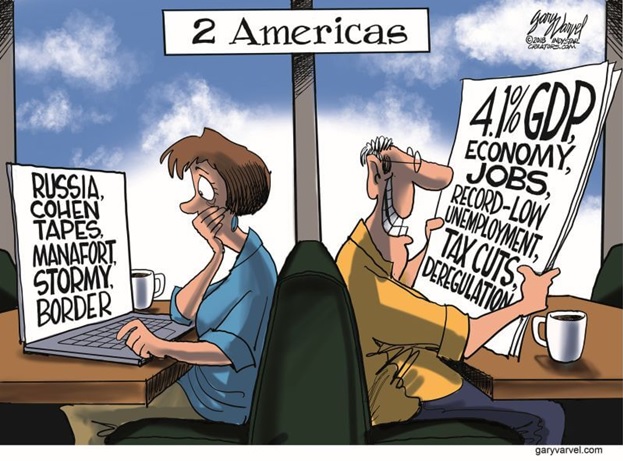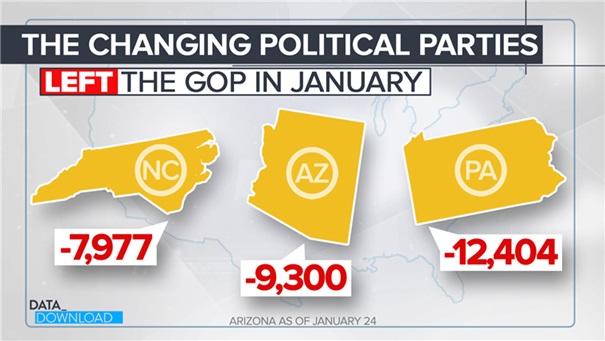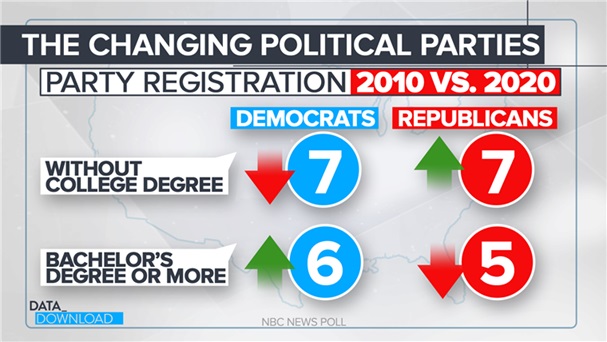GOP registration drop after Capitol attack is part of a larger trend.

As voters and former elected officials leave the Republican party, the drifts in voter identification come into focus.
WASHINGTON - Feb. 7, 2021 — In the weeks since the January riot at the Capitol, there has been a raft of stories about voters across the country leaving the Republican Party. Some of the numbers are eye-catching and suggest that the GOP may be shrinking before our eyes, but a closer look at the numbers over time shows that a larger change has been working its way through the party for some time.
In fact, when one takes into account shifts in the composition of the Democratic Party, the real story seems to be more about a deeper remaking of the nation’s two major political parties.
In Pennsylvania, more than 12,000 Republicans dropped the "R" from their registrations in January. In North Carolina, the figure was close to 8,000. In Arizona the figure was about 9,200 through late-January. And in one county in California, San Diego, more than 4,700 Republicans left the party last month.
To be sure, the headlines from the last few weeks have been striking, with multiple states reporting large declines in Republican voter registrations.

Those are sizable changes and they are much larger than the moves away from the Democrats in those places, but they come with some caveats. There are always some losses and gains in registrations for the Democrats and Republicans. Partisan identity can be fluid for a large chunk of the voters, and remember: just because a voter is registered with one party doesn’t mean he or she always votes for its candidates.
The question of why these former Republicans decided to leave the party is complicated. Some might feel the party has gone too far in supporting former President Donald Trump and some might feel it has not gone far enough.
Yet, in a broader sense, these numbers and others show party movement and they suggest a larger change may be underway within the GOP and the Democrats. Data from the NBC News poll show some notable changes over the last decade.
We took merges of our poll data from 2010 and 2020 to look at the profiles of the two major parties over that time and we found big shifts in education, profession and gender. Let's start with education.

Since 2010, the percentage of self-identified Democrats with a college degree has grown by 6 points, while the percentage without education beyond high school has declined by 7 points. On the Republican side, the story is reversed. The percentage with at least a college degree has declined by 5 points. The percentage without education beyond high school has climbed by 7 points.
It’s worth noting that a decline in college degrees within the GOP is going against the broader tide. It's happening as the number of college-educated Americans increased overall by 5 points. In fact, these numbers could be a warning sign for the Republicans. The party’s growth area in educational attainment, those with a high school diploma or less, is the one that is a shrinking percentage of the U.S. population.
To be clear, those education figures are not measures of intelligence, but they are very much measures of educational attainment and, to some extent, of economic opportunity. And together they affect the economic forces hitting each party. In the last 10 years the GOP has become more a blue-collar bastion.
In the last 10 years, blue-collar voters have become a bigger part of self-identified Republicans (growing by 7 points), while the blue-collar numbers have shrunk among Democrats (declining by 2). At the same time, white-collar voters have become a much bigger part of the Democratic Party and are up by 6 points. Even as Republicans have seen a gain with white-collar voters, by 4 points, the gains haven't kept up with their blue-collar boom.
Numbers like those might help explain some of the policy changes coming from the Republicans, particularly around the issue of trade.
And beyond education and occupation, the parties have seen some sharp shifts in gender.

Democrats have long been a party where women outnumber men, but the difference has grown. In the last decade, self-identified Democrats have gone from 42 percent male and 58 percent female in 2010 to 39 percent male and 61 percent female in 2020. And self-identified Republicans, who were once evenly split between genders in 2010, have become more male. In 2020, the self-identified Republicans were 54 percent male and 46 percent female.
Those changes seem likely to affect a wide range of policies for both parties, from reproductive rights to health care and paid family leave. It’s also worth noting that women actually make up about 2 percent more of the United States population than men. In other words, in terms of gender, the Democrats' growth is coming from the slightly larger piece of the demographic pie.
These are the numbers to keep in mind as you track the movement in and out of the two major parties in the coming weeks and months. It's not just about people moving; it's who is moving.
And as the demographics and socioeconomics of the two parties change, the core beliefs and values of the Democrats and Republicans will likely change as well. Politics is about people expressing their beliefs and advocating for what they want. That changes as the people in a political party change.
In that way, numbers like these do more than identify who is entering and exiting the two major parties. They show the outlines of a political realignment.
******
Dante Chinni is a data journalist and writer specializing in data analysis around campaigns, politics and culture. He uses numbers and on-the-ground reporting to understand the socio-economic, cultural and political forces that are shaping the United States.










